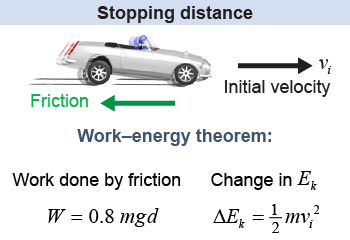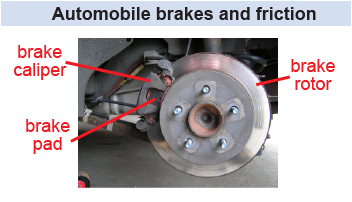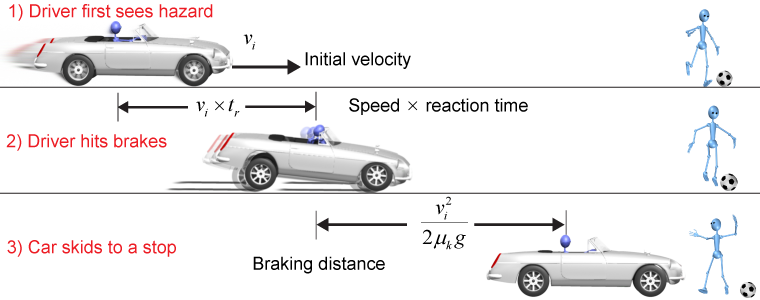|
“If you can read this, you’re too close.” Have you ever seen a bumper sticker that says this? It is used to discourage tailgating—the act of driving too close to the moving vehicle in front of you. How close is too close? The work–energy theorem holds the key to this practical physics question. 
|
 Suppose a car is traveling at 30 m/s (67 mph). The maximum force of traction between the road and a car is typically about 0.8mg, or 80% of the car’s weight. How much distance does the car need to stop? In a real situation there would be other factors, such as driver reaction time, but in this physics problem assume zero reaction time. The work done by the reaction force from braking decreases kinetic energy to zero.
Suppose a car is traveling at 30 m/s (67 mph). The maximum force of traction between the road and a car is typically about 0.8mg, or 80% of the car’s weight. How much distance does the car need to stop? In a real situation there would be other factors, such as driver reaction time, but in this physics problem assume zero reaction time. The work done by the reaction force from braking decreases kinetic energy to zero. 
 |
 When you step onto the brake pedal of a car, you are controlling a mechanism called the brake calipers. The calipers press the rubber brake pads against a flat metal disk called the brake rotor, which is attached to the car’s wheel. The brake pads on a car slow down the car through friction by rubbing against the rotors in the wheel. Kinetic energy lost by the braking car goes into heating up the brake pads through friction. Car and truck drivers (and even bicylists!) must exercise caution when braking down steep hills, because friction can cause so much heating that the surface of the brake pads can glaze over and stop working!
When you step onto the brake pedal of a car, you are controlling a mechanism called the brake calipers. The calipers press the rubber brake pads against a flat metal disk called the brake rotor, which is attached to the car’s wheel. The brake pads on a car slow down the car through friction by rubbing against the rotors in the wheel. Kinetic energy lost by the braking car goes into heating up the brake pads through friction. Car and truck drivers (and even bicylists!) must exercise caution when braking down steep hills, because friction can cause so much heating that the surface of the brake pads can glaze over and stop working!
The material that is used in the manufacture of brake pads loses some of its frictional resistance as the temperature rises, a process that is called brake fade. This process is usually reversible once the temperature is lowered again. If the heat becomes excessive, the surface of the brake pad can glaze over irreversibly. One key to avoiding brake fade is to design the brakes so that they have more efficient air cooling. Drum brakes are more susceptible to brake fade than disk brakes, because the drum brake design does not allow air to flow as easily across the brake pads. One strategy drivers use to cool their brakes down a long hill is to pump the brakes on and off; the brake pads are allowed to cool each time the brakes are released temporarily. Drivers also will shift down to a lower gear in order to use the additional friction within the engine itself to keep the vehicle’s speed low. 
|
| Asked: | distance d | | Given: | v = 30 m/s; F = 0.8mg | | Relationships: | W = Fd; Ek = ½mv2 | | Solution: | Set the work done equal to the change in kinetic energy:
Fd = ½mv2 → 0.8mgd = ½mv2
d = v2/(2×0.8g) = (30 m/s)2/(2×0.8×9.8 m/s2) = 57 m (190 ft) |
|
We can draw a very important point from the solution to the problem above: Stopping distance is proportional to the square of velocity, or d ∝ v2. Twice the speed means four times the stopping distance! This means that a car initially traveling at 60 mph needs four times the stopping distance compared to a car traveling 30 mph. And that’s not all. If you see a hazard ahead it takes time—your reaction time tr— to apply the brakes. Since distance equals the product of speed and time, this will add vi×tr to the amount we calculated earlier. At 30 m/s, each one-half second of reaction time adds another 15 m of stopping distance, or almost 50 ft. 
 |
The maximum reaction force that slows a car occurs when the tires are still rolling but on the verge of skidding. Once a car actually starts skidding, the friction coefficient changes to kinetic friction, and the stopping force is reduced. The purpose of an antilock brake system (ABS) is to sense when a wheel is about to “lock-up” and start skidding. The ABS automatically reduces the brake pressure, allowing the wheel to “spin back up,” then reapplies maximum braking force, all in a tenth of a second. The grinding noise you hear when ABS is activated is normal—it is the sound of the brakes rapidly pulsing on and off to achieve the maximum braking force much more quickly than your foot could. 
|

|
When accounting for friction between tires and the road for a skidding vehicle, the force of sliding friction is μkmg, not mg (or 0.8mg as in the problem above). The equation for stopping distance is then d = v2/(2μkg). If the coefficient of kinetic friction μk is small, as is the case for a wet or icy surface, then the stopping distance becomes very large! 
|
Suppose a car has a speed of 20 m/s and suddenly brakes. The car then skids for a distance of 10 m before coming to a stop. How far would the car have skidded if it had been traveling at 60 m/s instead?
 |
Skidding distance is proportional to the square of the car’s initial speed. The new speed, 60 m/s, is three times the original value of 20 m/s. Therefore, the new skidding distance will be nine times the original value, or 90 m—nearly the length of a football field! 
|
Assume that the coefficient of kinetic friction μk between a car’s tires and the roadway is 0.8 when dry and 0.4 when wet. Now imagine that a driver suddenly brakes, and her car skids 15 m on dry pavement. How far would the car have skidded if the pavement had been wet? (Assume that the initial speed is the same in both cases.)
 |
Stopping distance is given by d = vi2/(2μkg). Since the friction coefficient μk is in the denominator, the distance increases when μk decreases. More specifically, d is inversely proportional to μk. Therefore, reducing the friction coefficient from 0.8 to 0.4 will double the skidding distance from 15 m to 30 m. (Check: Does it make sense that a car would skid farther on a rainy day than on a dry one?) 
|

